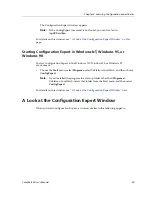
CoreWatch User’s Manual
45
Chapter 4: Learning Configuration Expert Basics
4.
If you wish to limit the range of your search to encompass only the immediate
subtree, turn on the
Search only subtree
option.
5.
Click the
Find Next
button. Configuration Expert searches the current configuration
file (or the specified portion of it) for the text string you entered in
step 2
.
Deleting Objects
You can delete any object you add except for VLANs. To delete an object:
1.
Select the object you want to delete.
2.
Select the File menu and choose
Delete Selection
.
3.
Click
OK
when Configuration Expert prompts you to verify whether you want to
delete the object.
Order of Configuration Tasks
Perform configuration tasks in the following order:
1.
Provide system information (such as the SSR’s name and location), define the SSR’s
ports, set up the SSR for a SYSLOG server and Domain Naming System (DNS)
servers, and configure the SSR for SNMP traps. For details on performing these tasks,
see
Chapter 5: “Changing System Settings” on page 49
.
2.
Configure bridging on the SSR as discussed in
Chapter 6: “Configuring SSR Bridging”
on page 65
.
3.
Group physical ports on the SSR by configuring VLANs as discussed in
Chapter 7:
“Configuring VLANs on the SSR” on page 87
.
4.
If you are using the SSR in an IP environment, create IP interfaces and then configure
those interfaces for unicast or multicast routing.
For details on IP interfaces, see
Chapter 8: “Configuring IP Interfaces for the SSR” on
page 107
. For details on unicast routing, see
Chapter 9: “Configuring Unicast Routing
on the SSR” on page 131
. For details on multicast routing, see
Chapter 10: “Configuring
Multicast Routing on the SSR” on page 147
.
5.
If you are using the SSR in an IPX environment, configure IPX interfaces as discussed
in
Chapter 11: “Configuring the SSR for IPX Routes” on page 159
.
6.
If you want to control traffic on the SSR, configure the SSR’s QoS policies as discussed
in
Chapter 12: “Configuring QoS on the SSR” on page 179
.
7.
If you want to set security on the SSR, define ACLs and Layer-2 security filters as
discussed in
Chapter 13: “Configuring Security on the SSR” on page 207
.
8.
If you want to set OSPF on the SSR, configure the SSR’s OSPF behavior as discussed in
Chapter 14: “Configuring OSPF on the SSR” on page 247
.
Summary of Contents for SSR-GLX19-02
Page 1: ...CoreWatch User s Manual 9032564 04...
Page 2: ...Notice 2 CoreWatch User s Manual...
Page 20: ...Preface 20 CoreWatch User s Manual...
Page 64: ...Chapter 5 Changing System Settings 64 CoreWatch User s Manual...
Page 86: ...Chapter 6 Configuring SSR Bridging 86 CoreWatch User s Manual...
Page 106: ...Chapter 7 Configuring VLANs on the SSR 106 CoreWatch User s Manual...
Page 206: ...Chapter 12 Configuring QoS on the SSR 206 CoreWatch User s Manual...
Page 246: ...Chapter 13 Configuring Security on the SSR 246 CoreWatch User s Manual...
Page 363: ...CoreWatch User s Manual 363 Chapter 16 Configuring Routing Policies on the SSR 9 Click OK...
Page 364: ...Chapter 16 Configuring Routing Policies on the SSR 364 CoreWatch User s Manual...
Page 370: ...Chapter 17 Checking System Status 370 CoreWatch User s Manual...
Page 390: ...Chapter 18 Monitoring Real Time Performance 390 CoreWatch User s Manual...
Page 396: ...Chapter 19 Checking the Status of Bridge Tables 396 CoreWatch User s Manual...
Page 430: ...Chapter 20 Checking the Status of Routing Tables 430 CoreWatch User s Manual...
Page 442: ...Chapter 22 Obtaining Reports 442 CoreWatch User s Manual...
Page 456: ...Appendix B CoreWatch Menus 456 CoreWatch User s Manual...






























